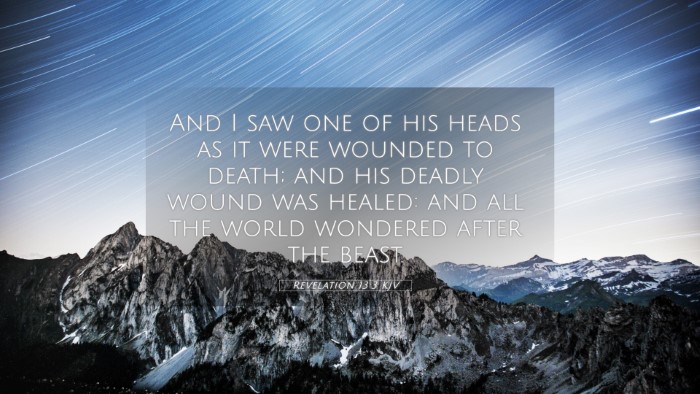Understanding Revelation 13:3
Revelation 13:3 presents a profound verse that speaks of the beast's fatal wound that was healed. This verse is rich in symbolism and has been the subject of extensive interpretation throughout biblical scholarship. In this exegesis, we will summarize insights from prominent public domain commentaries, including those by Matthew Henry, Albert Barnes, and Adam Clarke, to provide a comprehensive understanding.
Verse Breakdown
Revelation 13:3: "And I saw one of his heads as it were wounded to death; and his deadly wound was healed: and all the world wondered after the beast."
Context & Interpretation
The context of Revelation 13 describes the rise of the beast, often interpreted as a figure embodying opposition to God and persecution of the saints. The imagery of the wounded head signifies a significant blow to the beast's power, yet its miraculous healing evokes awe and admiration from the world.
Commentary Insights
Matthew Henry's Commentary
Matthew Henry indicates that the "wounded head" could symbolize a powerful leader or empire that seems to suffer a significant defeat, only to resurge with even greater influence. This healing is a deceptive miracle, akin to that of the Antichrist, leading many astray. The reaction of the world—wonder and worship—highlights humanity's tendency to idolize power, especially in times of crisis.
Albert Barnes' Notes
Albert Barnes explores the idea that the healed wound represents the resilience of evil systems in opposition to divine authority. He emphasizes the importance of recognizing the true source of this power, which ultimately leads to spiritual deception. Barnes suggests that the world's admiration of the beast suggests a spiritual blindness, wherein people prefer false security over the truth of God’s Word.
Adam Clarke's Commentary
Adam Clarke notes that this verse metaphorically describes the rise and fall of oppressive regimes throughout history. The "deadly wound" could represent moments of apparent defeat in the Christian narrative, yet it serves to illustrate God's ultimate sovereignty and the temporary nature of evil's triumphs. Clarke warns readers to remain vigilant against the allure of such false wonders that lead away from the Gospel.
Thematic Connections
The themes present in Revelation 13:3 resonate deeply with numerous other biblical passages. Here are ten relevant cross-references that illustrate the connections between this verse and other scripture:
- Revelation 17:8: The beast that ascends out of the bottomless pit, connecting to the idea of resurrection from apparent death.
- 2 Thessalonians 2:9-10: The coming of the lawless one, emphasizing deceptive miracles.
- Daniel 7:25: The beast making war with the saints, common themes of persecution and power.
- John 5:43: Jesus warning of others coming in His name, echoing the deceptive admiration seen in Revelation 13:3.
- Matthew 24:24: Warning of false christs and prophets who perform signs and wonders.
- Luke 4:23: Jesus speaks of healings that provoke wonder, a parallel to the beast’s miracle.
- Revelation 13:14: The beast deceiving those on earth through the miracles, reinforcing the theme of deception.
- Exodus 7:11-12: Sorcerers of Egypt replicate the signs of Moses, a historical reflection of spiritual counterfeits.
- Isaiah 14:13-14: The prideful fall of the king of Babylon resembles the fate and rise of the beast.
- Matthew 28:11-15: The narrative of deception after Christ's resurrection, illustrating the persistent challenge of truth against lies.
Conclusion
In conclusion, Revelation 13:3 serves as a critical point in the narrative of the Revelation, illustrating the allure of power and deception through the symbolism of the beast’s fatal wound that is healed. The insights from Matthew Henry, Albert Barnes, and Adam Clarke contribute to a deeper understanding of the text, emphasizing vigilance among believers as they navigate through the potential for spiritual deception in the world.
This verse, rich with connections to other scriptural themes, allows for an extensive comparative analysis, inviting further exploration of its implications for faith and conduct in contemporary settings.
















